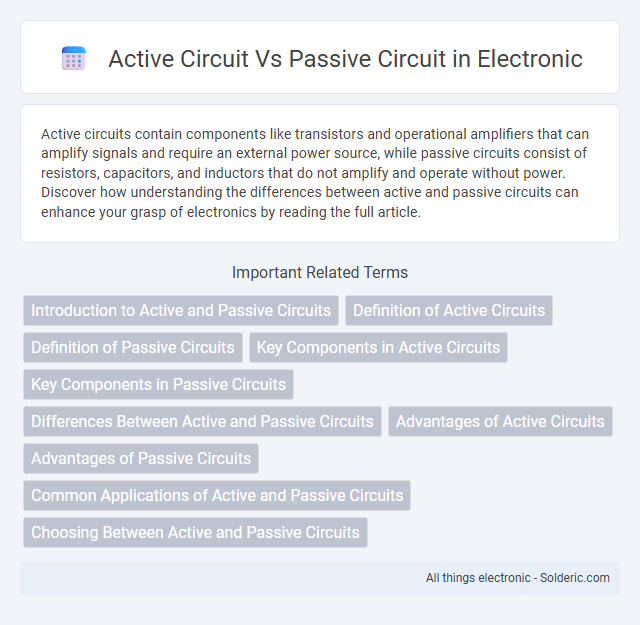Active circuits contain components like transistors and operational amplifiers that can amplify signals and require an external power source, while passive circuits consist of resistors, capacitors, and inductors that do not amplify and operate without power. Discover how understanding the differences between active and passive circuits can enhance your grasp of electronics by reading the full article.
Comparison Table
| Feature | Active Circuit | Passive Circuit |
|---|---|---|
| Definition | Contains at least one active component (transistors, ICs) that can amplify signals. | Consists only of passive components (resistors, capacitors, inductors) without signal amplification. |
| Power Requirement | Requires an external power source. | Does not require external power. |
| Signal Amplification | Capable of signal gain. | No signal gain; may attenuate signals. |
| Components | Transistors, diodes, integrated circuits, operational amplifiers. | Resistors, capacitors, inductors, transformers. |
| Complexity | More complex, requires biasing and power management. | Simple design, easy to analyze. |
| Applications | Amplifiers, oscillators, active filters, signal processing. | Filters, attenuators, impedance matching, energy storage. |
| Frequency Response | Can be designed for wide or selective frequency ranges. | Frequency response limited by passive components' properties. |
| Noise | Can introduce electronic noise due to active elements. | Generally low noise, passive elements do not add noise. |
| Cost | Usually higher cost due to active devices and power requirements. | Lower cost, simpler components. |
Introduction to Active and Passive Circuits
Active circuits contain components such as transistors, integrated circuits, and operational amplifiers that can amplify power and require an external power source to operate. Passive circuits are composed of resistors, capacitors, inductors, and transformers that do not provide gain and cannot introduce energy into the circuit, relying solely on the input signal's power. Understanding the difference between active and passive circuits is crucial for designing electronics that perform amplification, filtering, or signal processing functions.
Definition of Active Circuits
Active circuits contain components such as transistors, diodes, and integrated circuits that require an external power source to operate and can amplify signals or provide gain. These circuits are essential in applications where signal processing, amplification, or switching is needed. Understanding active circuits helps you design electronic systems that manipulate electrical signals efficiently.
Definition of Passive Circuits
Passive circuits consist of electronic components like resistors, capacitors, and inductors that do not require an external power source to operate. These circuits can only attenuate or store energy, lacking the ability to amplify signals compared to active circuits. Understanding passive circuits is essential for designing stable and energy-efficient electronic systems tailored to your needs.
Key Components in Active Circuits
Active circuits rely on components such as transistors, operational amplifiers, and integrated circuits that require external power sources to amplify signals and perform complex functions. These key components enable control over voltage and current, making active circuits essential in applications like signal processing and amplification. Understanding the role of these elements helps you design efficient electronic systems with enhanced functionality compared to passive circuits.
Key Components in Passive Circuits
Passive circuits primarily rely on resistors, capacitors, and inductors to control current and voltage without requiring external power sources. These key components store or dissipate energy but do not provide gain or amplification, making passive circuits inherently stable and simple. Your understanding of these fundamental elements is crucial for designing efficient filters, attenuators, and impedance matching networks.
Differences Between Active and Passive Circuits
Active circuits contain components such as transistors, integrated circuits, and operational amplifiers that require external power sources to amplify signals or control current flow, while passive circuits only consist of resistors, capacitors, inductors, and transformers that do not need power to operate. Active components can inject energy into the circuit, enabling amplification, oscillation, and switching, whereas passive components can only store or dissipate energy without signal gain. The key difference lies in the power requirement and the capability to control or amplify electrical signals within active versus passive circuits.
Advantages of Active Circuits
Active circuits offer significant advantages including the ability to amplify signals, which passive circuits cannot achieve. They provide better control over circuit functionality, enabling complex operations such as modulation, oscillation, and filtering. Your electronic designs benefit from increased functionality and improved performance due to the inclusion of active components like transistors and operational amplifiers.
Advantages of Passive Circuits
Passive circuits offer advantages such as simplicity, reliability, and low cost due to the absence of power sources and active components. These circuits generate minimal noise, ensuring stable signal processing and enhanced performance in many electronic applications. Your designs benefit from passive circuits' durability and reduced maintenance requirements, making them ideal for long-term use.
Common Applications of Active and Passive Circuits
Active circuits are commonly used in amplification, signal processing, and power regulation, where components like transistors and operational amplifiers boost or modify electrical signals. Passive circuits, consisting of resistors, capacitors, and inductors, find applications in filtering, impedance matching, and energy storage without requiring external power sources. Your electronic projects often combine both to achieve efficient signal control and processing.
Choosing Between Active and Passive Circuits
Choosing between active and passive circuits depends on your need for signal amplification or energy supply. Active circuits, which contain components like transistors and integrated circuits, amplify signals and require an external power source, making them ideal for applications needing signal boosting or processing. Passive circuits use resistors, capacitors, and inductors without external power, offering simplicity and reliability for filtering, tuning, or impedance matching in electronic systems.
active circuit vs passive circuit Infographic

 solderic.com
solderic.com